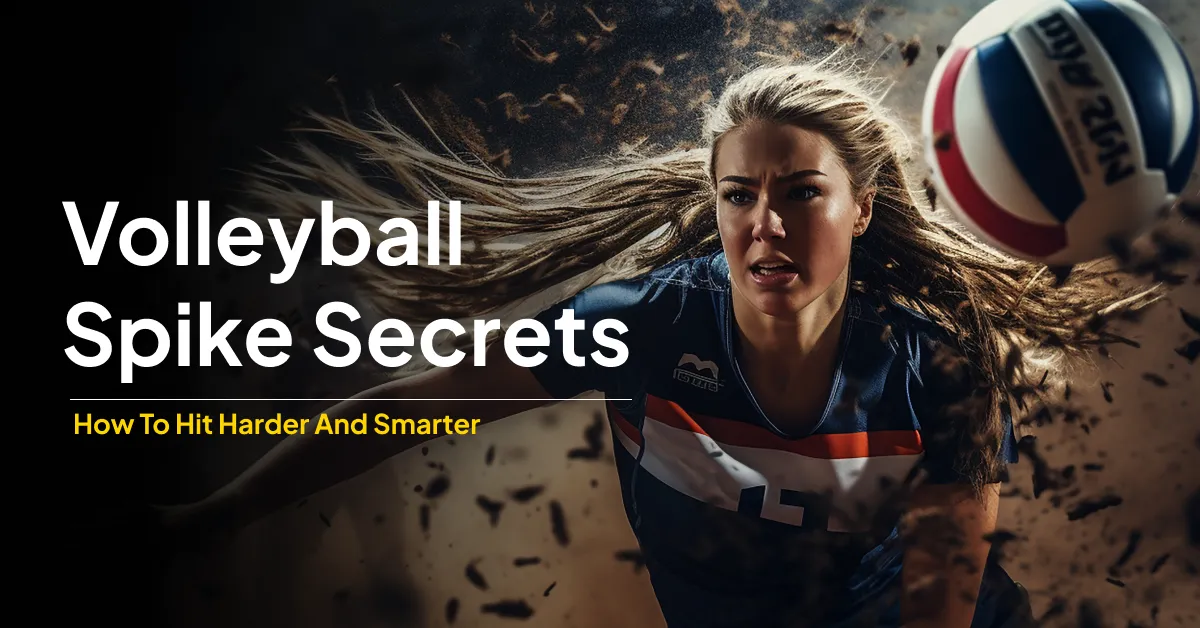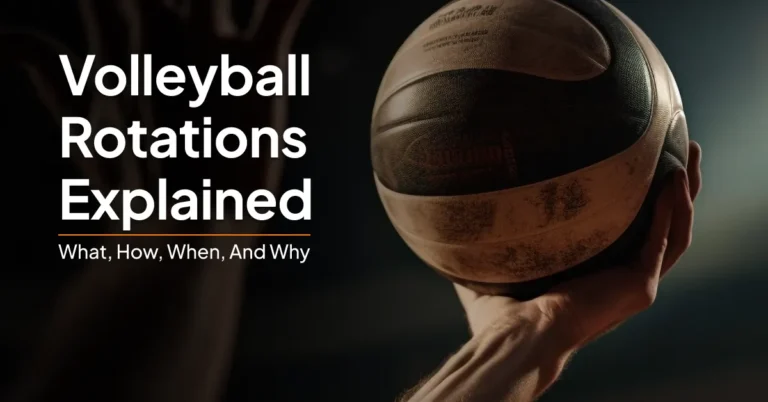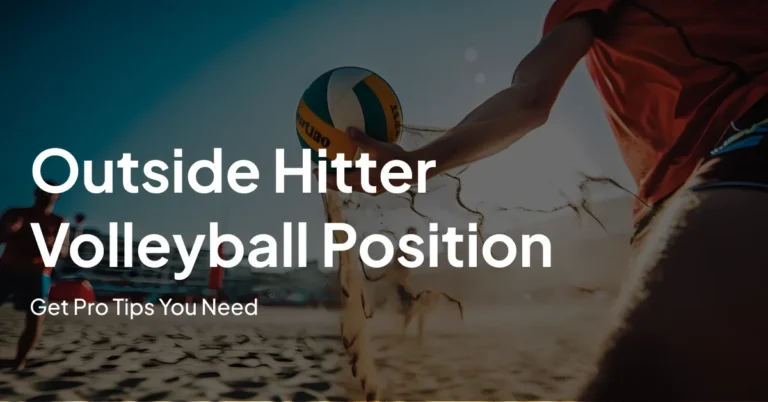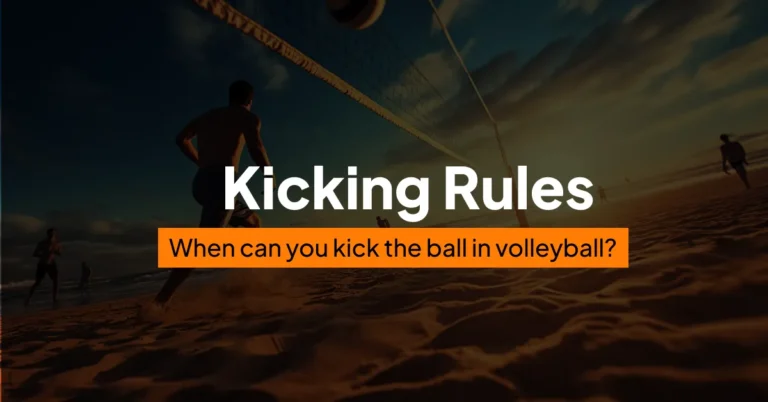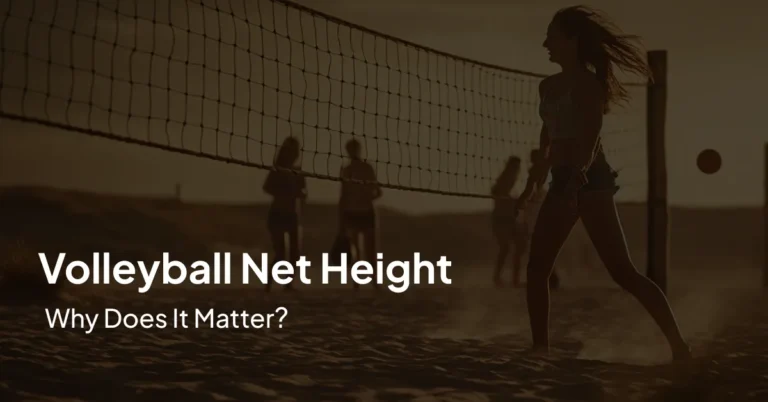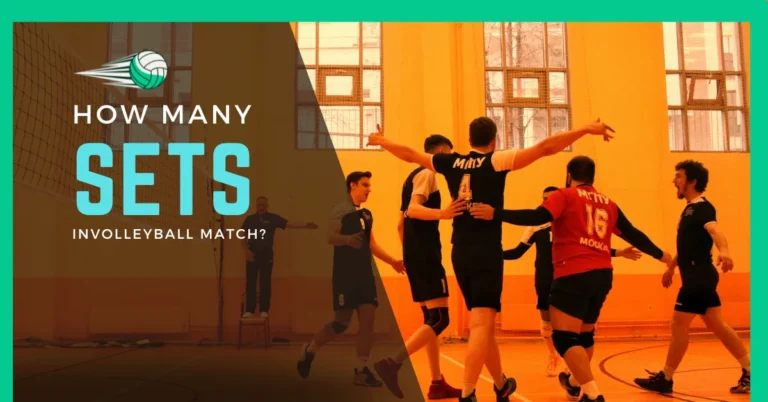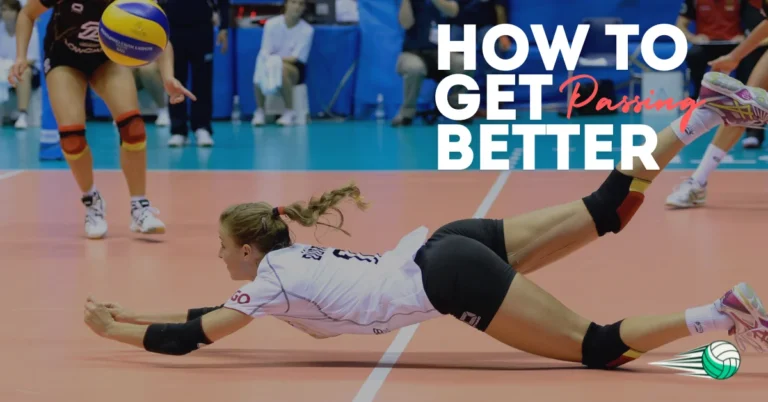Volleyball Spike Secrets: How to Hit Harder and Smarter
Welcome to the supreme guide to becoming a pro at spiking in volleyball. We are here to help you step up your game and make spiking a breeze.
Throughout this guide, we promise to share easy tips on footwork, approach, arm usage, timing, communication, and mental strategies. You do not need to be an expert, we will break it down for you in simple terms.
From knowing where to start your attack, attaching a straightforward four-step approach, and talking smoothly with your setter to seeing the set and expanding your spiking range, we have got you covered.
Plus, we will discuss some mental tricks to stay calm so that you avoid mistakes and believe in yourself. Get ready to spike like a pro.
Are you Beginner, and want to know the basics of Volleyball? Readout our latest guide: How to play Volleyball: Spike, Set and Serve like a Pro
FOCUS ON FOOTWORK TO GET BETTER AT SPIKING A VOLLEYBALL
One of the most essential aspects of becoming an effective volleyball spike is controlling proper footwork. Your footwork sets the relation for a powerful spike and can greatly impact your overall performance on the court.
Let’s explore the different scenarios and footwork techniques that can help you upgrade your spiking game to new heights.
Where Should You Start Your Attack From?
Before diving into the specifics of footwork, it is important to understand where you should make your attack on the court. This strategic decision plays an important role in maximizing your spiking potential and utilizing the weaknesses of the opposing team’s defense.
1. Footwork for Serve Receive:
When you find yourself as the receiver, your footwork can greatly impact your ability to execute a successful spike. Proper positioning and Flexibility are key factors in receiving a serve effectively and setting yourself up for a powerful attack.
You ARE the Receiver, Receive the Ball with Clarity
If you are the selected receiver for your team, your footwork should focus on positioning yourself in a way that allows you to receive the ball with Clarity and accuracy. Start by assessing the server’s attitudes and adjust your position accordingly.
Keep your feet shoulder-width separate, with one foot slightly in front of the other to maintain balance and flexibility. As the ball approaches, respond off the balls of your feet and transfer energy into your spike.
You are NOT the Receiver
In situations where you are not the selected receiver, your footwork should create optimal position for an effective volleyball spike. Expect the track of the ball and adjust your approach accordingly. Move towards the setter and maintain a balanced posture and ensure your spike approach is adjusted with the setters timing. This coordination will enhance your spikes power and accuracy.
1.2. Footwork from Defense Transition
Switching from a defensive position to an attacking one requires logical footwork and precise timing. Mastering this aspect of footwork allows you to convert defensive saves into powerful spikes that catch the opposing team off guard.
When shifting from a defensive position, respond off the balls of your feet and move yourself forward towards the net. Maintain a low and balanced posture to ensure a quick and explosive movement.
As you approach the net, coordinate your footwork with the setters positioning by adjusting your step to match their tempo. This coordination will improve your spikes timing and make it more challenging for the opposing team’s defense to react.
1.3. Footwork Off Blocking
Footwork off blocking in volleyball refers to the movement and positioning of a players feet after they have attempted to block the ball at the net.
In simple terms, after jumping to block, players need to quickly adjust their foot placement based on where the ball is going. Good footwork off blocking helps players maintain balance and be ready for the next play, whether it is to hit the ball back, defend, or move to another position on the court. It is about being active and ready for whatever comes next in the game.
APPROACH FOOTWORK TO INCREASE THE EFFICIENCY OF VOLLEYBALL SPIKE
When it comes to volleyball, the spike is undoubtedly one of the most exciting and effective harmful moves in the game. Mastering the volleyball spike requires not only power but also Skill and perfection. One important aspect that contributes to a successful spike is the approach to footwork. In this section, we will delve into two key elements: the 4-step approach and effective communication with your setter.
4 Step approach
The 4-step approach is a fundamental technique used by volleyball players to maximize their efficiency and power during a volleyball spike. It involves four clear steps that players take before executing the final jump to spike the ball.
First Step: The first step of the approach sets the relation for the entire sequence. Ideally, it is essential to start with the left foot for right-handed players and the right foot for left-handed players. This step should be quick, small, and explosive, moving the player forward while maintaining balance.
Second Step: The second step builds upon the strength generated from the first step. It should be longer than the initial step, ensuring a smooth changeover into the sequent moves. The goal is to move in a straight line toward the setter, adjusting the body with the intended target for the spike.
Third Step: The third step marks the preparation for the final jump. In this step, players should focus on speeding up their speed and height through a more forceful step. The arms begin to swing back, preparing for the subsequent forward motion during the jump.
Fourth Step: The fourth step is the ultimate moment, the jump. Players turn upwards, driving off their toes and utilizing their arm swing for maximum power. The timing is important here, as players must adjust their approach with the setters set. With the right timing and execution, the spike can be loosed with optimal force and perfection.
Communicate with your setter
Apart from mastering the footwork, effective communication with your setter plays a critical role in executing a spike successfully.
Verbal Communication: Volleyball is a fast-paced game, and effective verbal communication is essential to ensure proper timing and perfection in each play. Develop a dependent relationship with your setter by using specific hand signals or pre-agreed words to convey your intentions.
For example, a quick tap on the head could point to a desired quick set, whereas a tap on the hip might signal a high set.
Non-Verbal Communication: Communication is not limited to words alone. Non-verbal cues can enhance the connection between the spiker and the setter.
Establish Clever eye contact or develop a personalized hand gesture that allows for quick and seamless understanding. Practice these words during training sessions to inform yourself of your setter’s playing style and preferred signals.
HOW TO USE ARMS PROPERLY FOR AN EFFECTIVE SPIKE IN VOLLEYBALL
If you want to be a superior force on the volleyball court, learning how to execute an effective volleyball spike is essential. While several components contribute to a successful spike, one of the key factors is how you utilize your arms. Let’s explore the organic process of using your arms properly to maximize the height, power, and accuracy of your spikes.
1) Help you jump higher
One of the primary functions of your arms in a spike is to provide the necessary force to help you jump higher. By utilizing your arms effectively, you can generate greater upward force and gain that slight edge over your opponents.
To achieve this, start with a proper arm swing motion. As you approach the ball, swing your arms backward, generating momentum. Just before you are about to jump, talk your arms forward forcefully and extend them above your head. This explosive arm movement will transfer the energy to your legs and give you that extra boost to achieve greater height during your jump.
2) Power
Another important aspect of utilizing your arms in a volleyball spike is generating power. The strength and speed with which you swing your arms greatly influence the force with which you hit the ball that makes it difficult for the opposing team to defend.
To maximize power, focus on the timing and coordination of your arm swing. As the ball approaches, add your non-dominant arm up and use it as a guide to determine the Way and timing of your spike. As you jump, forcefully swing your dominant arm forward and maintain a flexed elbow throughout the motion.
This will enable you to generate significant power and transfer it effectively to the ball upon contact, resulting in a powerful spike that can catch your opponents off-guard.
3) Aiming
While jumping high and hitting the ball with power is important, aiming is equally important to ensure your spike lands in the desired location on the opponent’s court. Proper arm positioning and control play an essential role in achieving accuracy during a spike.
TIMING AND COMMUNICATION WITH THE SETTER
Volleyball is a team sport and effective communication is the backbone of a well coordinated team. When it comes to timing and executing the perfect spike, then communicating with your teammates, especially the setter, becomes even more important.
During a game, be pieced and communicate with your setter to let them know your intentions. Effective communication between you and the setter will ensure that you both are on the same page, which is critical for a well-coordinated attack.
What Does Your Setter Need from You?
To execute a perfect spike, it is essential to understand what your setter needs from you. The setter is responsible for delivering a well placed set that allows you to approach and jump effectively.
By understanding their perspective, you can position yourself optimally and make their job easier.
First, your setter needs clear and concise signals from you. Use hand signals or verbal cues to indicate the type of set you are looking for. Whether it is a high set, a quick set, or a backset, ensure that your setter knows exactly what you need to maximize your spikes potential.
Furthermore, your setter relies on your movement and positioning to anticipate the timing of the spike. Communicate with your setter about your approach speed and timing preferences, allowing them to adjust their set accordingly.
What Do You Need from Your Setter?
Just as your setter has specific needs from you, there are certain aspects you should expect from your setter to enhance your spike.
Firstly, your setter should provide you with accurate and consistent sets. As a hitter, you rely on your setter’s ability to deliver the ball to your preferred hitting zone consistently. This allows you to time your approach correctly and generate maximum power for your spike.
Secondly, your setter should be attentive to your signals and communication. It is important that your setter understands your requests and can customize their sets accordingly. This level of understanding and responsiveness can elevate your game and make your spikes more effective.
Lastly, your setter should be adaptable and open to feedback. Each player has their unique preferences, and your setter should be willing to adjust their sets based on your input. This two-way communication ensures a stronger connection between you and your setter, resulting in more successful spikes.
VOLLEYBALL SPIKE TIP: SEEING THE SET!
Playing volleyball is all about teamwork, communication, and proper techniques. Now we will be focusing on an essential tip for mastering the spike – seeing the set.
If you are a right-handed player
If you happen to be a right-handed volleyball player, you are in luck! Seeing the set becomes slightly easier due to the natural positioning of your body. As a right-handed hitter, your approach starts on the left side of the court, which gives you a clearer line of sight to the setter. This advantage allows you to evaluate the set better and position yourself accordingly.
See the set
The first important step is to see the set. The set refers to how the ball is positioned for you to attack it. It is the responsibility of the setter to position the ball at the optimal height and location for you to execute a successful spike. By visually tracking the Route of the ball as it leaves the setter’s hands, you can determine the speed and direction of the set.
To enhance your ability to see the set, keep your eyes focused on the setter’s hands and the ball throughout the game. By maintaining a great visual connection with the setter, you can react more quickly and adjust your approach accordingly.
Pay attention to the perceptive meanings in the setter’s body language, as it can provide valuable hints about the type of set that is coming your way.
Don’t circle around – its a Mistake
One common mistake many volleyball players make is circling after the set. Instead of staying in the same spot, they tend to move in a circular motion and hope to gain a better angle for the spike. However, this movement can keep your effectiveness as a hitter.
To maximize your hitting potential, it is important to avoid circling and maintain your position relative to the setter. By holding your ground, you create a more predictable target for the setter. This consistency allows them to better gauge the distance, timing, and angle required for the set, resulting in a more accurate delivery.
VOLLEYBALL SPIKE: PUTTING IT ALL TOGETHER
A perfect spike requires precision, power, and strategy. Here are the key features to help you improve your spiking range by avoiding common mistakes. Spike with patience and use the word “yet” to unlock your full potential on the court.
Improving your range with your spike in volleyball
During spiking, expanding your range of shots is important. By learning different techniques, you can keep the opposing team guessing and increase your chances of scoring.
Consider tipping or rolling the ball
One effective way to improve your range is by incorporating tip shots and rolls into your Cache. Instead of always going for a powerful spike, sometimes a soft touch can throw off the defense and find gaps in their formation. A well executed tip or roll can catch the blockers off guard, earning you valuable points.
Aim for the holes in the block
Another essential aspect of expanding your range is learning to aim for the holes in the block. As you approach the net, analyze the positioning of the opposing blockers.
Look for gaps or weaknesses in their arrangement, such as little arrangements or slow reactions. By adjusting your angle and targeting these gaps, you can increase your chances of scoring, even against a solid block.
Volleyball spike without making a mistake
While power and action are important in spiking, you must try to minimize errors. A well executed spike can bring light but a mistake can cost your team valuable points. Here are 3 tips to spike effectively while avoiding errors.
- Timing is key: Pay close attention to the setters positioning and timing. Maintain good communication with your setter to ensure a well timed connection between the two of you. A mistimed spike can easily result in an error.
- Focus on technique: Proper technique plays an essential role in reducing errors. Ensure that you have a solid approach, a strong arm swing, and a precise contact point. Practice your footwork, arm pullback, and wrist snap to maintain control over your volleyball spike.
- Evaluate the block: Keep an eye on the opposing blockers and evaluate their moves. If their hands are positioned high or shifted to one side, adjust your angle or aim for a different spot to avoid hitting directly into the block.
Be Quick, But Don’t Hurry
Patience is worth it when it comes to spiking in volleyball. While it is essential to be quick in your movements and decision making, speed can lead to errors. Strive for a balance between speed and calm.
Using the word “yet”:
The power of the word “yet” lies in its ability to shift your mindset and embrace growth. By adding “yet” to your vocabulary, you acknowledge that there is room for improvement and that setbacks or failures are temporary.
Accepting mistakes as opportunities
Instead of getting discouraged by mistakes, view them as opportunities to learn and grow. “I have not perfected my spike yet, but I am working on it.” This mindset fuels your motivation and Strength, ultimately leading to progress.
Final Words
Overcome the art of volleyball spike with our comprehensive guide. From footwork finesse to mental mastery, we cover it all. Learn to position yourself strategically, communicate effectively with your setter, perfect your arm technique, and upgrade your game with patience and accuracy. Accept the mindset of continuous improvement, and soon you will be spiking like a pro.

